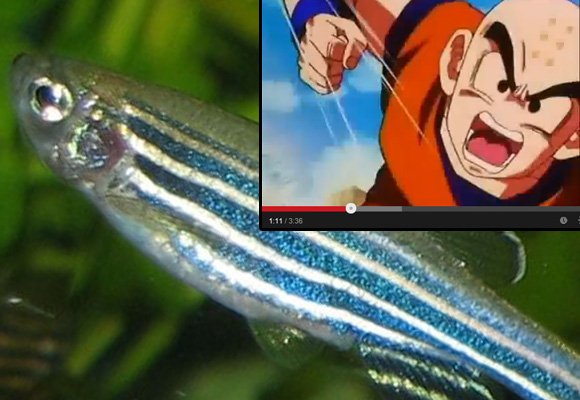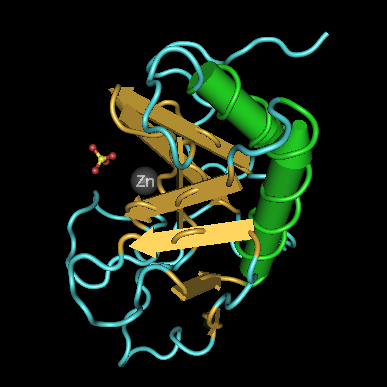
The zebrafish is an interesting member of the minnow family for a number of reasons. They cute, fairly cheap, and relatively easy to take care of as pets making them great for warming up the old homestead. On the other hand, they are widely used in labs due to their speedy reproduction and development along with their fully sequenced genome.
Krillin, meanwhile, is an interesting recurring character of the Dragon Ball series. The most popular fully human character, he has developed the power of flight and powerful energy disc. He’s also one of the more versatile dressers of the series sporting outfits and hairstyles beyond his fighting gear.
So what is it that connects this fictional fighter to the freshwater fish?
The answer was revealed on Twitter recently by someone scouring scientific literature.
ゼブラフィッシュの変異型で鼻がちゃんと形成されず匂いを感じない個体がいるんだけど、この鼻の形成に関わる遺伝子を『クリリン』と言う。ドラゴンボールマニアの研究者が命名した。マジで論文も出てた。http://t.co/TTMBcNl0Cw pic.twitter.com/BgJ7lGlZN6
— ジェット・リョー (@ikazombie) March 28, 2014
The Twitter user mercifully explains the meaning of the scientific jargon in the image saying that there is a mutant variety of zebra fish with an improperly developed olfactory system and thus nearly complete inability to smell. This mutant and the gene responsible for it were both named kuririn (abbreviated as KRR).
Fans of Dragon Ball have surely already jumped to the conclusion that Krillin (Or Kuririn in Japanese), despite being one of the most human characters, oddly lacks a nose. Clearly we have an Akira Toriyama fan or two on that research team. However, it would seem pop-culture references could be found tucked away in many scientific journals.
Zebrafish also have very strong regenerative abilities such as regrowing lost body parts; something else these two seem to have in common.
■ Souther Gene
Research studying flies with situs inversus isolated the gene responsible which he dubbed the Souther gene (Myo31DFsouther). Situs inversus is the condition where a person’s internal organs such as the heart are found on the opposite side of the body than normal. This condition was a big part of what made the Holy Emperor Souther such a formidable opponent in Fist of the North Star.
■ Sonic Hedgehog Gene

■ Pikachurin
Pikachurin is a protein that functions in the photoreceptor ribbon synapse which is basically the process in which the eyes and brain communicate. For the body to work such a process effective it takes the fast and precise movements of its name sake Pikachu. However, Pikachurin is said to assist in eye health whereas Pikachu can at times be bad for it.
WARNING: The following video is said to possibly induce epileptic seizures
There are probably lots of other proteins and genes named after manga, anime, and video game characters. To uncover them, all you have to do is head down to your local library and start flipping through back issues of scientific journals. Go ahead! I’m sure it’ll be fun.
Source: Twitter via My Game News Flash (Japanese)
Video: YouTube – MrAndyCretin, Code0x, Curseco
Zebrafish Image: Wikipedia – Azul
Sonic Hedgehog Image: Wikipedia – Peter Znamenskiy

 What do Chicago hot dogs, a Japanese admiral, and a gold tooth have in common?
What do Chicago hot dogs, a Japanese admiral, and a gold tooth have in common? Sonic the Hedgehog getting a new CG Netflix series produced in the U.S. and Canada
Sonic the Hedgehog getting a new CG Netflix series produced in the U.S. and Canada Genetically altered rice could solve Japan’s pollen allergy problem
Genetically altered rice could solve Japan’s pollen allergy problem We visit Japan’s first hedgehog cafe in Roppongi, Tokyo【Pics & Video】
We visit Japan’s first hedgehog cafe in Roppongi, Tokyo【Pics & Video】 Pregnant Japanese woman’s ultrasound looks eerily like a character from anime Dragon Ball Z
Pregnant Japanese woman’s ultrasound looks eerily like a character from anime Dragon Ball Z McDonald’s new Happy Meals offer up cute and practical Sanrio lifestyle goods
McDonald’s new Happy Meals offer up cute and practical Sanrio lifestyle goods All-you-can-drink Starbucks and amazing views part of Tokyo’s new 170 meter-high sky lounge
All-you-can-drink Starbucks and amazing views part of Tokyo’s new 170 meter-high sky lounge More foreign tourists than ever before in history visited Japan last month
More foreign tourists than ever before in history visited Japan last month Starbucks reopens at Shibuya Scramble Crossing with new look and design concept
Starbucks reopens at Shibuya Scramble Crossing with new look and design concept Studio Ghibli glasses cases let anime characters keep an eye on your spectacles
Studio Ghibli glasses cases let anime characters keep an eye on your spectacles Hamster abandoned at Tokyo ramen restaurant gets new home
Hamster abandoned at Tokyo ramen restaurant gets new home One of Tokyo’s most famous meeting-spot landmarks is closing for good
One of Tokyo’s most famous meeting-spot landmarks is closing for good Foreign English teachers in Japan pick their favorite Japanese-language phrases【Survey】
Foreign English teachers in Japan pick their favorite Japanese-language phrases【Survey】 Is the new Shinkansen Train Desk ticket worth it?
Is the new Shinkansen Train Desk ticket worth it? Tokyo’s most famous arcade announces price increase, fans don’t seem to mind at all
Tokyo’s most famous arcade announces price increase, fans don’t seem to mind at all Disney princesses get official manga makeovers for Manga Princess Cafe opening in Tokyo
Disney princesses get official manga makeovers for Manga Princess Cafe opening in Tokyo Beautiful new Final Fantasy T-shirt collection on the way from Uniqlo【Photos】
Beautiful new Final Fantasy T-shirt collection on the way from Uniqlo【Photos】 Japanese convenience store packs a whole bento into an onigiri rice ball
Japanese convenience store packs a whole bento into an onigiri rice ball We try out “Chan Ramen”, an underground type of ramen popular in the ramen community
We try out “Chan Ramen”, an underground type of ramen popular in the ramen community Studio Ghibli releases Kiki’s Delivery Service chocolate cake pouches in Japan
Studio Ghibli releases Kiki’s Delivery Service chocolate cake pouches in Japan Japan’s bone-breaking and record-breaking roller coaster is permanently shutting down
Japan’s bone-breaking and record-breaking roller coaster is permanently shutting down New definition of “Japanese whiskey” goes into effect to prevent fakes from fooling overseas buyers
New definition of “Japanese whiskey” goes into effect to prevent fakes from fooling overseas buyers Our Japanese reporter visits Costco in the U.S., finds super American and very Japanese things
Our Japanese reporter visits Costco in the U.S., finds super American and very Japanese things Studio Ghibli unveils Mother’s Day gift set that captures the love in My Neighbour Totoro
Studio Ghibli unveils Mother’s Day gift set that captures the love in My Neighbour Totoro Foreign passenger shoves conductor on one of the last full runs for Japan’s Thunderbird train
Foreign passenger shoves conductor on one of the last full runs for Japan’s Thunderbird train Domino’s Japan now sells…pizza ears?
Domino’s Japan now sells…pizza ears? New Japanese KitKat flavour stars Sanrio characters, including Hello Kitty
New Japanese KitKat flavour stars Sanrio characters, including Hello Kitty Kyoto creates new for-tourist buses to address overtourism with higher prices, faster rides
Kyoto creates new for-tourist buses to address overtourism with higher prices, faster rides Sales of Japan’s most convenient train ticket/shopping payment cards suspended indefinitely
Sales of Japan’s most convenient train ticket/shopping payment cards suspended indefinitely Sold-out Studio Ghibli desktop humidifiers are back so Totoro can help you through the dry season
Sold-out Studio Ghibli desktop humidifiers are back so Totoro can help you through the dry season Japanese government to make first change to romanization spelling rules since the 1950s
Japanese government to make first change to romanization spelling rules since the 1950s Ghibli founders Toshio Suzuki and Hayao Miyazaki contribute to Japanese whisky Totoro label design
Ghibli founders Toshio Suzuki and Hayao Miyazaki contribute to Japanese whisky Totoro label design Doraemon found buried at sea as scene from 1993 anime becomes real life【Photos】
Doraemon found buried at sea as scene from 1993 anime becomes real life【Photos】 Tokyo’s most famous Starbucks is closed
Tokyo’s most famous Starbucks is closed One Piece characters’ nationalities revealed, but fans have mixed opinions
One Piece characters’ nationalities revealed, but fans have mixed opinions We asked a Uniqlo employee what four things we should buy and their suggestions didn’t disappoint
We asked a Uniqlo employee what four things we should buy and their suggestions didn’t disappoint Princesses, fruits, and blacksmiths: Study reveals the 30 most unusual family names in Japan
Princesses, fruits, and blacksmiths: Study reveals the 30 most unusual family names in Japan Kansai area people more genetically predisposed to liking coffee than elsewhere in Japan
Kansai area people more genetically predisposed to liking coffee than elsewhere in Japan Japanese researchers learn how to grow hair follicles, and probably new hair
Japanese researchers learn how to grow hair follicles, and probably new hair Cute hedgehog cools down like nobody’s watching 【Video】
Cute hedgehog cools down like nobody’s watching 【Video】 KISS singer Gene Simmons reacts to Love Live’s KISS parody
KISS singer Gene Simmons reacts to Love Live’s KISS parody Tekken 7 intro movie released
Tekken 7 intro movie released Marutaro the hedgehog is still as cute as a button, and now he’s a family hedgehog! 【Pics】
Marutaro the hedgehog is still as cute as a button, and now he’s a family hedgehog! 【Pics】 Rock legend Gene Simmons has no problem with otaku marrying their 2-D anime crushes
Rock legend Gene Simmons has no problem with otaku marrying their 2-D anime crushes Dragon Ball characters appear in Ford anime ad specifically made for English-speakers 【Video】
Dragon Ball characters appear in Ford anime ad specifically made for English-speakers 【Video】 Awesome Sega Mega Drive six-button controller taiyaki lets you bite into mouthful of nostalgia
Awesome Sega Mega Drive six-button controller taiyaki lets you bite into mouthful of nostalgia Sega apologizes after exec says Puyo Puyo players eat beef bowls with cheese
Sega apologizes after exec says Puyo Puyo players eat beef bowls with cheese Gene Kelly inspires short anime from Japan, captures hearts around the world
Gene Kelly inspires short anime from Japan, captures hearts around the world New Sputniko! music video presents modern take on traditional myth, inspired by real life science
New Sputniko! music video presents modern take on traditional myth, inspired by real life science Dog’s startled reactions to hedgehog pal take over the Japanese Internet【Monday Kickstart】
Dog’s startled reactions to hedgehog pal take over the Japanese Internet【Monday Kickstart】 Tired of looking for The One? Try Japan’s new DNA matchmaking service and maybe you’ll find them
Tired of looking for The One? Try Japan’s new DNA matchmaking service and maybe you’ll find them
Leave a Reply